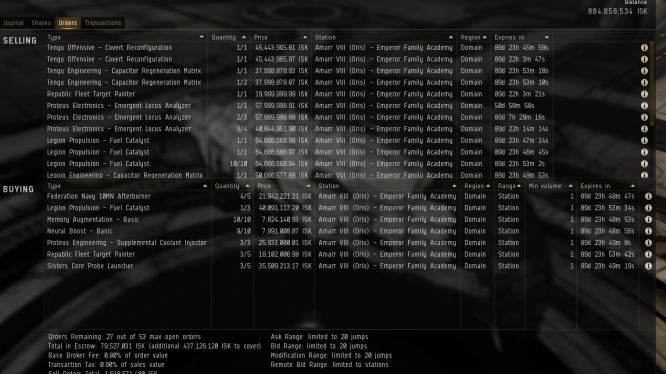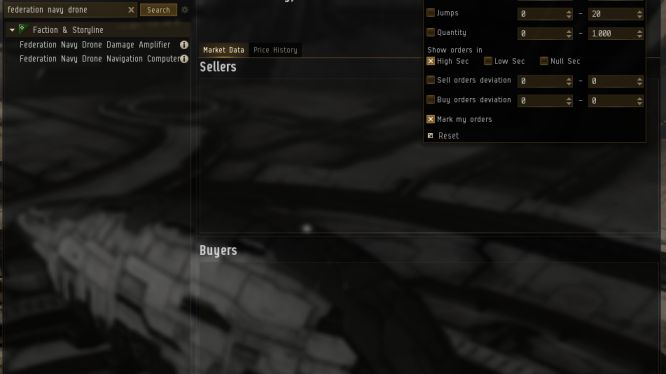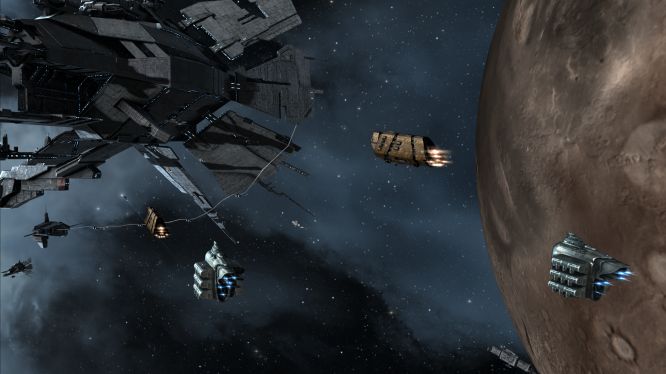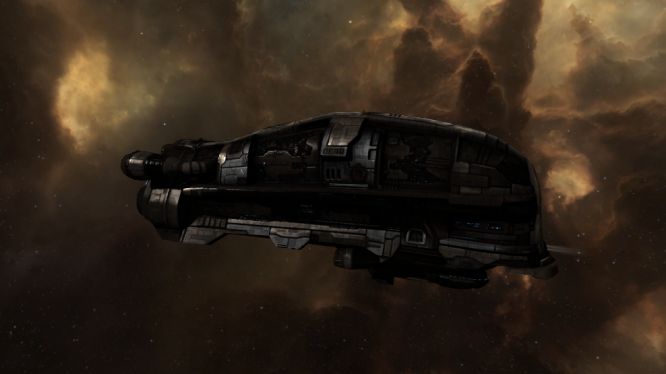Welcome to the third chapter of A Newbie's Guide to Margin Trading. It's been a long, strange road to this point. If you're joining us now and haven't had a chance to read the earlier parts of this guide, I highly recommend going back and reading through part one and part two to give yourself some context and make sure you haven't missed anything.
In this chapter of the guide, we'll begin to wrap things up with some discussion on updating buy and sell orders and some ideas on how to take your enterprise to the next level. Let's get trading!
Updating Those Orders - Welcome to the World of Market PVP
If you're new to EVE Online, let me give you a word of advice: No matter where you go or what you do, the PVP nature of EVE will find you eventually, and it will make you rue the day you first subscribed. Understanding that, at its very core, EVE Online is a game all about the struggle for dominance between one player and another is one of the best ways to ensure you have a good time. Player versus player content is everywhere in the game, and despite how many pilots stick their heads in the sand to try and hide from it, it always catches up to them eventually.
Embracing this mentality and applying it to your decisions in trading is going to give you a huge advantage on a mental level. Realizing that the buy and sell orders that surround yours are made by players just like you will help you understand how to tackle them.
So, if you've been following the guide, you'll have hopefully made a few buy and sell orders by now. If you're lucky, you might have already made a tidy little profit trading. Good job! You've probably also had some first hand experience with the most frustrating aspect of margin trading: competition.
Unfortunately, the problem with chasing the lucrative profits of margin trading is that you aren't alone. Hundreds if not thousands of players will be chasing those same profits and will be just as eager to push you out of the market.
Updating Your Orders
Buying or selling items on the market, as we previously discussed, is done by creating standing buy or sell orders which other players can then fulfill. Of course, with a market that is influenced by the forces of supply and demand, it makes sense that there is always going to be competition. Other players will want to beat your prices so that they get the sale. Working to defeat them can be tricky and exhausting.
For starters, whenever your sell order isn't the lowest available price that someone is looking to buy from, or your buy order isn't the highest available price that someone is looking to sell to, you will lose out on any potential money. Players will be constantly updating their orders in an attempt to edge you out of potential sales, and you'll need to fight back.
By clicking on your wallet, you can view some of your financial information. Near the top, you'll see a tab called Orders. Pressing that tab takes you to an overview of all of your current buy and sell orders and, I've found, is the easiest way to manage your trading.
Now, by double-clicking on any of your orders, you will automatically open the regional market window displaying the prices for that particular item. Take some time to arrange the windows so that you can access both easily, because, once you have dozens of orders to update, you'll need to flip back and forth easily. With the window open (and making sure that you've properly sorted the regional market to display lowest prices in station first if you're selling, and highest prices if you're buying) you can see the current going rate for that item. Is that price the same as what you're selling? No? Great! Time to update your order.
Before we do that, however, let's do one thing that will make your life infinitely easier.
By clicking on the little gear you can access some options for the regional market window. Take a look and familiarize yourself with these, as eventually you'll probably want to make use of them in some capacity. The one we want to make sure is checked "mark my orders." This will highlight your orders so that you can easily distinguish them from the others on the market.
Now, right click on your order in the wallet window and select modify. You will now see another window not unlike the buying and selling windows for when you initially place an order. Here, you can update your prices accordingly. Be sure to use your scroll wheel on your mouse if you have it to update orders that have only changed a few cents. That way, you can save yourself precious time and energy from having to carefully select the price and adjust it each time. If you have a number pad (as most keyboards should), get comfortable using it!
That's it! Easy, peasy. Go through and update all of your orders one by one. Be careful to make sure that the price you are adjusting it to beats the best price for that item, and make sure that they haven't changed any digits higher up in the value that you might have glazed over.
Now, here comes the frustrating part: Orders can only be updated once every five minutes. The problem here is that lots of players will immediately update their orders following your recent update, locking you out of first place for another five minutes. This is where things can become frustrating if you don't have time to sit at the computer updating orders every five minutes.
This is where the PVP aspect of trading comes in, as with some clever tactics you can help guarantee that your orders are the primary ones being filled. Here are some quick and easy tips:
It is very common for players to modify orders to beat another player's order by only 0.01 ISK. This way, they can edge you out while maintaining the value of the item they are trying to trade. Get use to only adjusting orders one or two ISK.
If you're facing fierce competition, trying subtly changing the price of your order in other areas including the 0.01 ISK. For example, if an item is listed at 12,900.93, modifying your buy order to 12,800.92 might cause your competition to slip up when modifying their own order, effectively earning you another five minutes of spotlight!
Split buy and sell orders into multiple orders (this is where those trading skills come in handy)! This way, if someone edges out your order before your five minute timer is up, you can immediately respond by modifying another order to beat theirs in return. This is demoralizing and if you're aggressive enough, you might be able to make them give up.
Depending on your profit margins, you might try crashing the value of an item if you're willing to take the hit. This can work in your favor if the items you are looking for can still be flipped at a profit (albeit a lesser one) and might discourage others from competing with you. Be careful though, you might also unintentionally crash the market on that item, losing out on millions in profits. Don't ruin a good thing for everyone else just because you're not patient.
Refrain from using "calling card" tactics that players can use to identify you. Market trading isn't anonymous, but if you're consistently using the same numbers in your orders (for example, always decreasing the value by 10 ISK instead of 0.1) people might start to pick up on you. You want your market characters to be as inconspicuous as possible. The higher profile you are, the more people will track you and look for ways to sabotage you.
Choosing the Right Items to Trade
In part two, we discussed finding the right items to trade according to how healthy their current markets were. Unfortunately, there is another dimension we need to consider; how healthy is that item for your schedule?
Take Legion Propulsion - Fuel Catalysts for example. These are subsystems used on the highly demanding Tech 3 Strategic Cruisers, and go for a whopping 64 million ISK currently. The buying price for this item was at a paltry 40 million ISK, meaning each unit sold would net you a wicked 24 million ISK profit. Wow. If you're like me, you might have cautiously bought into the market.
Here's where things have gone horribly wrong for me. After acquiring roughly 10 units of this item, I've now realized that the lucrative profit and slow moving turnover have contributed to creating a highly competitive market that I simply cannot keep up with. Every minute, new orders are being updated to match the current lowest price, and as a trader who only updates his prices a couple of times a day, I'm almost immediately edged out.
We all make poor decisions.
This is why it is so important to cautiously buy into a market, even if the deal seems incredible. Get a taste for the turnover and how fast you can flip an item before you invest millions of ISK. And remember these two tenets:
If you have the time to babysit orders all day, chasing high profit, low turnover items can be a good idea since you're able to remain competitive.
If you only have the time to update orders a few times a day, chase items with smaller profits but extremely high turnover. This will help your chances of filling orders even if you're not the best price, since the demand for that item (either to sell or buy) will fill orders faster than traders can create them.
Understanding which items are right for your playstyle is integral to making money in the market. Sometimes the biggest margins aren't worth chasing. Slow and steady wins the race.
We Need to Go Deeper! Taking Things to the Next Level
Kids grow up so fast, don't they! Weeks ago you couldn't tell a Donchian channel from a median day price, and now look at you! Okay, okay, condescending remarks aside, you've been kicking butts and taking names in the world of margin trading and you want to move things up a notch.
Well, the most obvious course is to trade in new and different materials with relatively bigger margins. As your investment capital continues to grow, you can begin to work in bigger markets. Eventually, with enough clout, you can begin trading in PLEX, the coveted item that you can use to purchase your subscription. Beyond PLEX, the next biggest item to deal in would be officer modules, rare implants, and perhaps even powerful tech 2 ships.
But let's pretend that margin trading isn't satisfying you like it once did and you're wanting to take this show on the road. While the guide is certainly not gospel for things like null-security trading, we can at least give you some tips to get on the right track.
Hauling and Region Trading
One way of making a killing is by margin trading but using the differences in EVE's different trade hubs as the source of your income. As each region is subject to different politics, suppliers, and events that can impact their respective markets, using that to your advantage can be just as lucrative.
Learning to Fly
In order to make use of this, you're going to need a ship capable of handling the task. The obvious go-to would be your racial industrial, but I might recommend taking the extra time to pursue the Amarr line of industrials. They're some of the best, and if you do decide to chase this all the way to flying a freighter, the Providence won't let you down.
One excellent choice is a Blockade Runner. These ships are fast and, more importantly, can fit a Covert Ops Cloaking Unit. While I wouldn't advise using these for null-sec transporting (unless you're a veteran and understand the risks of flying in such dangerous space) than can be a much safer alternative for carrying high value goods. Speaking of which, welcome to the first rules:
Never fly with cargo more valuable than the cost of suicide ganking your ship.
Never fly on autopilot.
Always fit a reasonable tank to your ship, especially with high value items.
Flying in a Blockade Runner, it can be really easy to let the speed and cloaking get to your head. One day you'll think to yourself, yeah, I can definitely carry 5 billion ISK worth of cargo and no one will notice. Wrong. They will. They always do.
Taking more trips is always the safest bet. Always fly with your ship adequately tanked to dissuade any would-be bandits, and always avoid dangerous systems if you can.
In the final chapter of this guide, we'll look a bit more at region trading, while showcasing some out of game tools you can use to help enhance your experience.
Next Time…
That's all we have time for this week. We'll keep this guide going again and be sure to check back next week as Final Frontier will be welcoming Arch Angel onto the column to talk more in depth about his time trading and lessons learned! For some extra information, be sure to check out the presentation he gave at this year's Fanfest!




